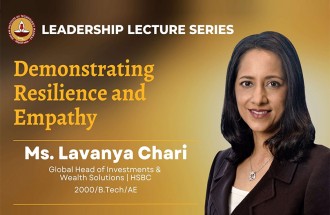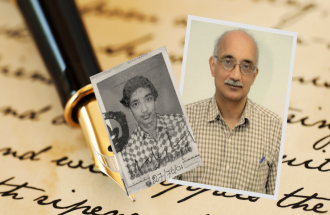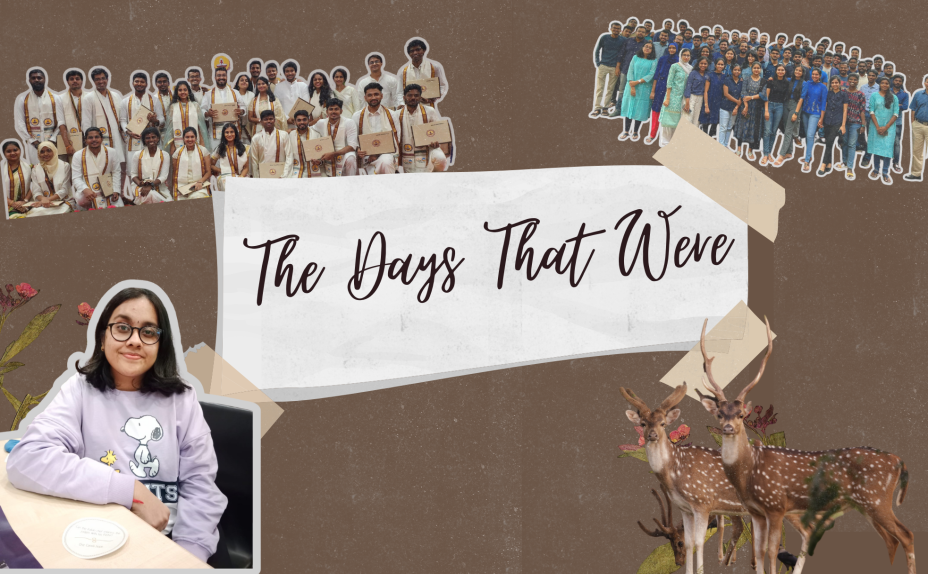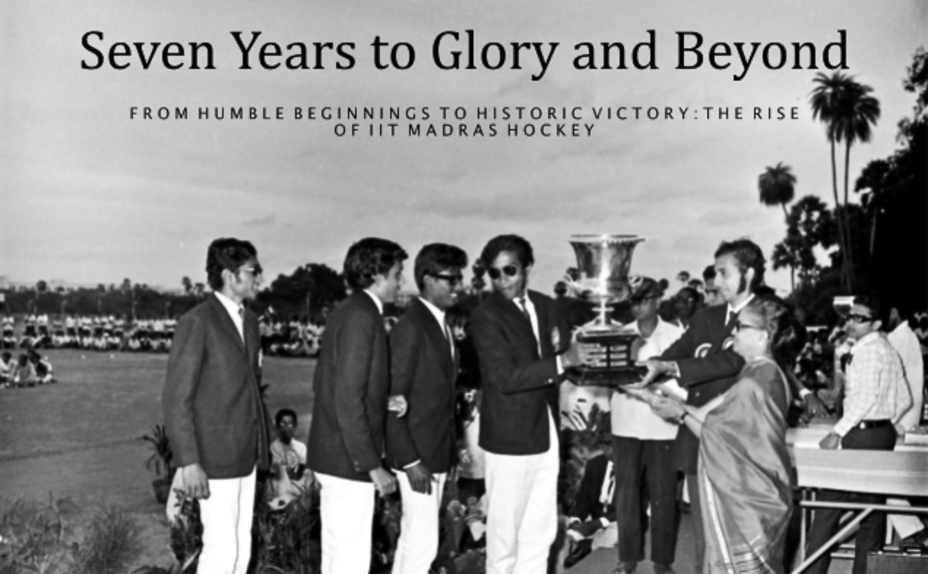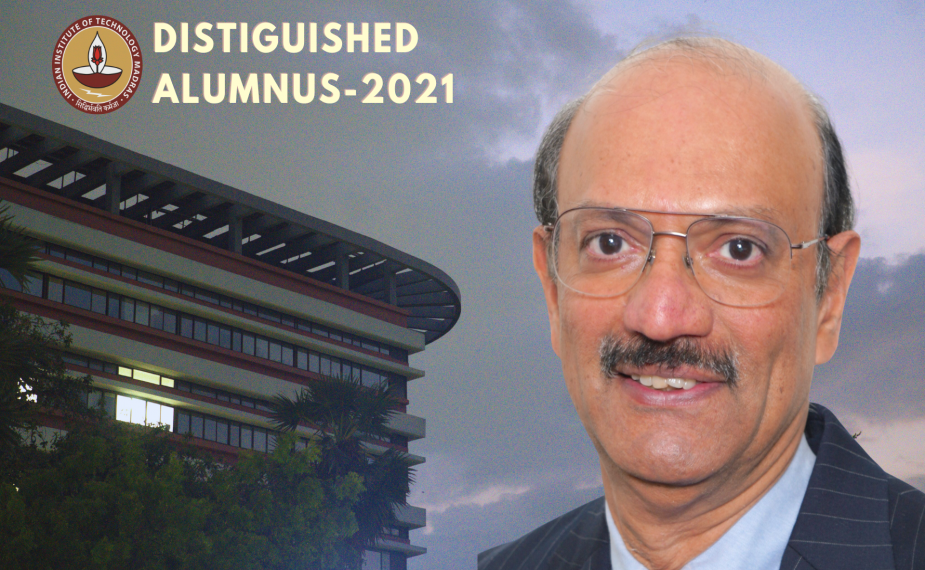
Discussions with a Distinguished Alumnus
1. Congratulations, Sir, on being awarded the DAA. How do you feel on this occasion?
Thank you for your kind wishes. I was elated when I was told I was a recipient of a 2021 DAA. It is a great honor to be recognized by my alma mater -- IIT Madras. I value this award as the most cherished among all the recognitions I have received so far.
2. It's been about 40 years since you left IITM. Do you have any fond memories that you could share with us?
2. It's been about 40 years since you left IITM. Do you have any fond memories that you could share with us?
I have lots of fond memories of my time in IIT Madras. It was one of the best times in my life. Here are some experiences which are vivid in my mind. As the Jamuna hostel’s mess secretary, I tried my best to improve the quality of food, and we made sure all dishes were washed in hot water. I clearly remember on one hostel day, Prof. Indiresan (director at that time) came promptly at the time we told him to come. However, we were not ready. He immediately left and told us to call him when we were ready. I was also the class president of the CE batch. I was lucky to have had an excellent relationship with the Dean, Prof. NVC Swamy, and could get lots of things done. In my final year, I had a Palmistry stall (I used to dabble in astrology and palmistry in my IIT days) at the Mardi Gras festival, along with N. Ravindra and Titus, and we had a great time reading the hands of all the young folks who came to visit us. Even the Director’s wife visited our stall. Apparently, we convinced a lot of people that we were experts in the field. I relished the treks to Taramani for Chai in the night with friends and was a frequent visitor, with Chopee, to the temple on grounds.
3. What shaped your interests and got you involved in the academic world? Please tell us more about your journey.
My maternal uncle, Prof. DV Reddy, was a professor of Applied Mechanics at IIT Madras during the 1960s. My mother decided that I should get into IIT Madras when I was 14 years old and become a professor like my uncle. I got a branch change from Civil to Electronics in my third year and probably spent a month there, but went back to Civil Engineering as my father wanted me to follow my uncle’s path, as I come from a family of doctors (Sir Alexander Flemming used to visit my Pathologist grandfather when he stayed in Madras) and my father had no clue about engineering. This worked out very well for me in the end. I wrote my first article sometime in 1978 or early 1979, entitled “To Smoke or Not to Smoke” for the IIT Campus Magazine – FOCUS. For my bachelor’s thesis, I worked on analysis of offshore structures with Prof. ASJ Swamidas. Later, we published a paper on this work. After IIT, I went to Carnegie Mellon University on an assistantship and initially worked on soil structure interaction problems – the problem of fast-moving trains on a rail track with Prof. Jacobo Bielak. After meeting with Prof. Raj Reddy, I decided to move into the use of artificial intelligence for civil engineering applications and did my doctoral dissertation in the area. This led to a job at the Massachusetts Institute of Technology, where I taught for eight years before moving to the National Institute of Standards and Technology.
4. What drew you towards information technology initially? How has it progressed over the years?
At CMU, I was extremely fortunate to have been under the tutelage of two great stalwarts in engineering and computer science – Profs Steven Fenves and Raj Reddy, who not only sowed the seeds for my research career but also provided guidance on how to generate the fruits of knowledge. As I was in Civil Engineering, I did not have much knowledge of computer science but decided to learn the fundamentals by taking several undergraduate courses. By the time I finished my PhD, I had a fairly strong foundation in computer science. As artificial intelligence was gaining increasing importance in the early 1980s, I decided to focus on applications of AI for engineering problems. The senior professors were very kind and gave the graduate students lots of freedom. I got together with students in other branches, and we published several papers on applications of AI (even wrote a couple of papers with IIT classmate Lalit Chordia on design) in a wide range of journals and conferences. One of my Civil Engineering batchmates, Sitaram, changed his job to come to CMU to learn about Artificial Intelligence. He even followed me to MIT later. I even laid the foundations for a new journal – AI in Engineering – while I was a graduate student.
I joined MIT in 1986, where I collaborated with Bob Logcher, who, along with Steven Fenves, developed the first large-scale analysis package on a digital computer. Bob and I envisioned that the Internet, which was really used for e-mail by engineers at that time, would transform the way design will be done. Although we had a lot of resistance from traditional engineering scientists, we managed to conceptualize and build one of the first computer-supported collaborative design environments, which had all the features that Facebook initially had (actually, with much better security mechanisms). This was feasible because of the world-class graduate students we had. I believe I learnt more from them than they did from me. In 1994, on the advice of Pradeep Khosla, I joined NIST to build an engineering design program in mechanical engineering (now called Engineering Laboratory). I was again lucky to have had the opportunity to work with some of the best researchers in the world and a management (in both Engineering and Information Technology Laboratories) that allowed us to be innovative and creative. I also worked on publications with IIT alumni Ravi Jandardhan, B. Gurumurthy, Lalit Chordia, and Soundara Kumara. Our work has had a significant impact on the practice of engineering in the industry. We were able to bring rigor to standards development. The interoperability standards and modelling languages developed by our team are resulting in improved productivity in the engineering and allied industries. (e.g., health care). The NIST design repository project has become the model for design repository research, used widely in the industry and the academia. Current progress in 3D printing of heterogeneous material would not have been possible without standards, whose foundations were laid by our team. In summary, our work – in the federal government -- has been very critical for enabling seamless integration of product design and manufacturing and, more importantly, the semantic integration of Computer Aided Design tools with Computer Aided Manufacturing and Computer Aided Engineering tools. Our contributions are being realized in the emerging areas of Smart Manufacturing, Industrial Internet of Things, Industrie 4.0, and Digital Manufacturing.
After nearly 16 years in the engineering laboratory, I moved in 2010 to take over the Software and Systems division in the Information Technology Laboratory, and I am continuing my journey toward building better software systems. We have had an impact in many areas, developing better and faster software and better quality health care through Electronic Health Record (EHR) certifications and medical device interoperability. Every EHR tested in the U.S. is based on NIST’s tools. Our voting guidelines are used during election reporting, our AI-based image analysis tools are helping in better treatments for macular degeneration, our computer forensics tools are helping various law enforcement agencies (the U.S. Supreme Court often cites our reports), and our timing work is making smart cities happen. I continue to collaborate with several IIT Madras alumni and IITM faculty members.
5. What role has IIT Madras played in charting your professional and personal trajectory? What would you say has been your biggest takeaway?
IIT Madras provides a solid foundation for pursuing any scientific and engineering discipline. The breadth of courses offered during the five-year Btech course has helped to make significant contributions in a variety of fields – civil, mechanical, health care, and computer science. Essentially, the groundwork for computational thinking was laid at IIT Madras and CMU. The high intellectual level of students, combined with a dedicated IIT Madras faculty, has provided a lifelong learning experience. As I mentioned before, I also taught at MIT for 8 years. On an average, I believe the IIT student is smarter than the MIT student, although there may be outliers. I am also impressed that IIT Madras has instituted courses such as self-awareness and integral karma, pioneered by Devdas Menon, which aid in developing engineers holistically.
On a personal level, there are several things I like to note. Since my schooling was mostly in small cities in Andhra Pradesh, my English language skills were not very good. However, my skills were honed by help rendered by several classmates – notably Devdas, Harsha, and Achyuth. And, insights into the Fast Fourier Transform from Unnam and Gopalan were very useful in my Bachelor’s thesis. The power of collaborative problem-solving helped all of us get through many exams. I also got initiated into Yoga and Transcendental Meditation (TM), which I practice every day. At IIT, I formed everlasting bonds with many of my peers, and some of them became more of a family to me, and that is the biggest takeaway.
6. How do you balance an exceptionally driven professional life with your other interests?
Apart from doing Yoga and TM every day, I also enjoy reading Indian philosophy, interacting with IIT batchmates on WhatsApp, watching cricket and American football, and cooking Indian food. My mother was a great cook, and I have collected her recipes over the years. This collection was an inspiration for my niece’s recent cookbook – A Heritage of Food. Family and friends play a very important role in our professional careers. And I am lucky to have great family and friends. I am what I am because of my parents.
7. What would your message to the young students and professionals of the Institute be?
When I joined IIT, I got this piece of advice from my uncle Prof. DV Reddy: “No matter what you do, try to be the best in your field. If you are a stone mason, you should try to be the best stone mason in the world.” That is what I always strive for. In your life’s journey, you will encounter several obstacles. Do not worry about the obstacles you face in your professional and personal life. Oftentimes people may not believe in your ideas. Believe in yourself and be persistent. It will pay off in the long run. Clearly understand the purpose of anything you do and be persistent in achieving that purpose. Never burn bridges if you can avoid doing so. As described in Indian scriptures, treat Ahamkara or ego as a formidable enemy and try your best to suppress this. Family is important. Make sure you spend time with your family. Always maintain bonds with your college mates. Having good mentors like Profs Raj Reddy, Steven Fenves, and Vint Cerf, and supporters like Profs. Azad Madni, Pradeep Khosla, Jyoti Mazumder, Lalit Chordia, and Sartaj Sahni is important. Many of you will become leaders in your field. Leadership involves working closely with your peers, your technical staff, and administrative staff and gaining their trust. Always remember your alma mater and try to give back in whatever way you can. Finally, you should never stop learning. Learning should be a lifelong experience.


